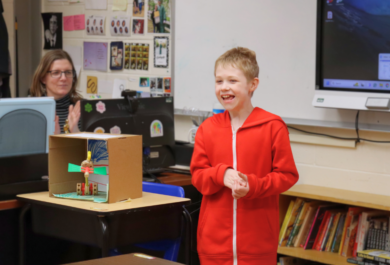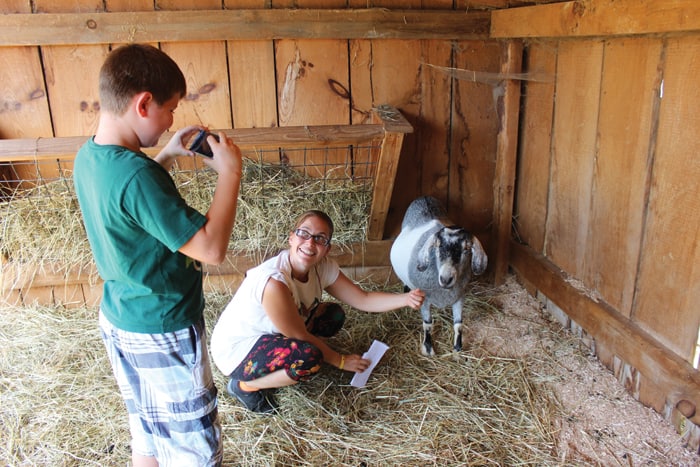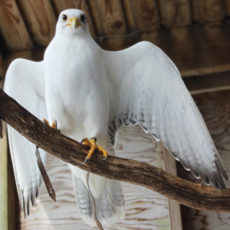Announcements

“I’m useless. I can’t do anything,” cried Emmet. He had isolated himself in the bathroom again; his refuge whenever things felt to be too much.
“Can you catch a ball,” asked his social worker, Tara Doran. “Yes,” he replied tentatively through the bathroom door.
“What about a cartwheel?”
“Of course.”
“Well, those are things I can’t do – do you think I’m useless?” asked Tara.
“No.”
“Do you think you could teach me to do a cartwheel?”
“I guess I could,” he muttered while opening the door.

It was a symbolic moment for the pair. Emmet was a 7th grader at Green Chimneys School and the slightest inkling of change, from being given a new assignment to returning to school after a weekend, often sent Emmet into crisis. For children who struggle with social and emotional challenges, transitions are more significantly felt – something both Emmet and his family knew all too well.
Tara was just beginning to work with Emmet, and she quickly saw she needed to create opportunities for him to experience success and develop a sense of pride. Her primary goal would be to foster Emmet’s confidence so that one day he’d know he can tackle whatever comes his way.
Soon Emmet was spending weekly therapy sessions with animals. Tara’s plan incorporated walking dogs around campus and visiting goats at the farm to focus on activities that would bring Emmet enjoyment, allow him to relax, and make him feel capable. Their first few animal-assisted sessions quickly broke down much of the typical resistance associated with a child opening up to a new therapist.
This scenario was nearly 18 months ago and what has transpired since may seem like a miracle, but it’s really a credit to the hard work of Emmet and his treatment team here at Green Chimneys. Many Green Chimneys students, especially those who may struggle with anxiety, attention deficit disorder, or are on the Autism Spectrum, can find a session “in motion” and involving physical activity very helpful in feeling regulated, safe and secure. The task at hand can provide a distraction from compounded emotions or reflex responses and give a child the opportunity to take a break and refocus.
These days Emmet isn’t as easily discouraged by a new assignment; in fact, in June, Emmet began challenging himself with projects of his own invention. Currently he and Tara are touring campus, taking pictures and getting quotes from students and staff to highlight what Emmet calls, The Best of Green Chimneys.
Being able to integrate animals into work is what many of our staff describe as “stealth therapy.” Through caring for and interacting with a variety of animals in different scenarios, students are able to learn a range of skills including, mindfulness, emotional regulation and empathy, without it being instructional. And with the help of their clinicians, students are encouraged to apply these concepts into other areas of their life.
Using each student’s individualized education plan (IEP), Green Chimneys clinicians are actively and creatively utilizing the resources available to help children reach their therapeutic and education goals. Grooming a horse can help with focus and even mindfulness, a chance to practice deep breathing as an emotional regulation skill. Bottle-feeding a calf can help children on the autism spectrum, who often have difficulty thinking outside of themselves, realize the needs of another living being. And observing a herd of goats may help a child open up and relate the dynamics to that of his or her own family.
“The possibilities are endless,” explains Social Work Supervisor Toni DeMato. “What we do know is that each child requires an individualized approach to connecting and addressing the challenges she or he faces. I couldn’t be more pleased with the progress Emmet and Tara have made together, not to mention how they partner with animals to not only work together but to share experiences with others throughout the organization.”
You can make a difference in the lives of children with special needs and the animal who help them. Explore how

Crowned the best for falconry in medieval times, gyrfalcons were once reserved for kings. As the largest falcon in the world, with exquisite plumage ranging from bright white to deep charcoal, gyrs are revered for their powerful skill of flight. Their long wings make hunting waterfowl from 3,000-feet-high a feasible and fantastical feat. This falcon was flown in the sport of falconry for several years.